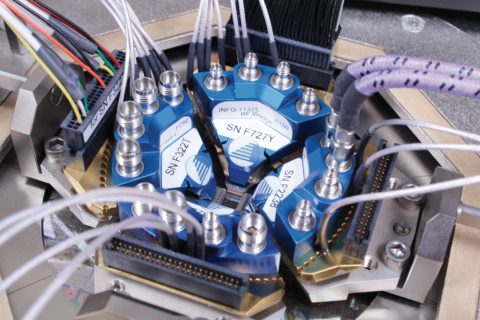Probing high pad count integrated circuits (ICs) in order to verify functionality has always been a challenge. As the number of on-chip connections increases and pad sizes get smaller, probing is becoming increasingly difficult, and nowhere is the challenge harder than when testing complex consumer RF devices. The need to minimize cost drives die size, and along with it, pad size, as small as possible. Functional tests need to be done reliably and with repeatable accuracy, as quickly as possible. To meet these needs requires a rethinking of how device probing is accomplished and the development of a fundamentally new component probing technology.
Danube Integrated Circuit Engineering (DICE) GmbH & Co KG of Linz, Austria provides a case in point. DICE designs and manufactures millimeter wave (mmW) receiver/transmitter ICs for automotive collision avoidance radar applications. Unlike cell phone RF front-end chips, which typically have relatively few connections to the outside world, the circuits that DICE makes can have close to 100 connections surrounding a 5 mm2 die, with up to 25 mixed-signal contacts per side. Chip cost constraints limit the size of the pads to just 80 µm x 80 µm.
The small pad size and high operating frequencies of these devices pose difficult challenges for test managers and the designers of probe solutions.
Read a case study that shows details on how DICE used InfinityQuad to overcome these challenges.
Additional Background on the DICE Case Study
Conventional probes using needles and coaxial probe tips do not have the accuracy to land on ultra-small pads exactly the same way each time. Needle probes can be bent or misaligned, causing issues with the planarity and positional accuracy of the probe tips.
Needle probes do not contact the circuits in an identical way from die to die and hence the test results can vary. Probes also expand and contract as the temperature changes (the automotive radar circuits that DICE manufactures are tested up to 125°C). This lack of precision and repeatability in probing can impact yields as good devices can get wrongly rejected.
Needle probes also pose testing problems in working with complex RF circuitry due to lack of impedance control. Probes with poor impedance control and shielding can have unwanted loss and act like antennas, generating interference on the signals on adjacent probes, affecting the accuracy of the testing process. In fact, older multi-contact probe technologies, even when using coaxial probes, are typically limited to handling signals up to a few GHz. The radar ICs that DICE manufactures operate at significantly higher frequencies (77 GHz).
The ability to probe small pads using conventional probes can also be affected by the inability to penetrate the layer of oxidation that forms on aluminum pads. Most consumer products use aluminum pads. To break through the oxide, probe tips are commonly “scrubbed” on the pad surfaces and the resultant damage to the pad allows for good contact between the probe tip and the pad metal. If the probe tips are large in size compared to the pads that they are probing (it is common for a tungsten needle probe to have a tip diameter of 20 µm and for an RF probe tip to have a diameter of 40 µm), the pads can receive excessive damage during the probing operation. In addition, if a lot of scrub is required to achieve a good probe connection, the chance of the probe tip skating off the pad increases.
An additional problem with conventional probes with multiple needles is that the needles have to “fan out” in order to get many contacts into a small area. This fanout creates a tendency for the probe needles to skate at an angle at the extremities of the probe array in respect to the forward skate in the center of the probe. This also limits how small the pads can be and still be probed reliably without excessive damage.
Because of the problems with conventional needle-probing technologies, manufacturing engineers at DICE were initially forced to test their radar ICs manually in order to ensure that the pads were contacted correctly. This process was time consuming and, because the process wasn’t automated, there was the possibility of errors being made that could impact product yield (good ICs might be damaged or judged to be bad due to imprecise testing). So, DICE manufacturing engineers looked for a better solution.
To see how DICE used our InfinityQuad™ Probe technology to solve this relatively common RF probing challenge, download our case study.
